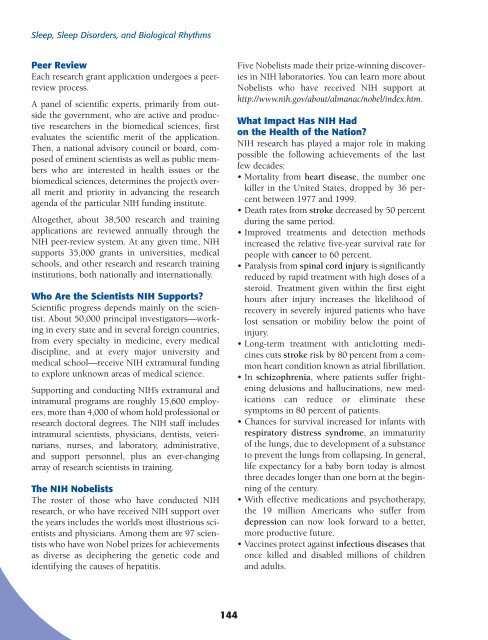Biological - NIH Office of Science Education - National Institutes of ...
Biological - NIH Office of Science Education - National Institutes of ...
Biological - NIH Office of Science Education - National Institutes of ...
Create successful ePaper yourself
Turn your PDF publications into a flip-book with our unique Google optimized e-Paper software.
Sleep, Sleep Disorders, and <strong>Biological</strong> Rhythms<br />
Peer Review<br />
Each research grant application undergoes a peerreview<br />
process.<br />
A panel <strong>of</strong> scientific experts, primarily from outside<br />
the government, who are active and productive<br />
researchers in the biomedical sciences, first<br />
evaluates the scientific merit <strong>of</strong> the application.<br />
Then, a national advisory council or board, composed<br />
<strong>of</strong> eminent scientists as well as public members<br />
who are interested in health issues or the<br />
biomedical sciences, determines the project’s overall<br />
merit and priority in advancing the research<br />
agenda <strong>of</strong> the particular <strong>NIH</strong> funding institute.<br />
Altogether, about 38,500 research and training<br />
applications are reviewed annually through the<br />
<strong>NIH</strong> peer-review system. At any given time, <strong>NIH</strong><br />
supports 35,000 grants in universities, medical<br />
schools, and other research and research training<br />
institutions, both nationally and internationally.<br />
Who Are the Scientists <strong>NIH</strong> Supports?<br />
Scientific progress depends mainly on the scientist.<br />
About 50,000 principal investigators—working<br />
in every state and in several foreign countries,<br />
from every specialty in medicine, every medical<br />
discipline, and at every major university and<br />
medical school—receive <strong>NIH</strong> extramural funding<br />
to explore unknown areas <strong>of</strong> medical science.<br />
Supporting and conducting <strong>NIH</strong>’s extramural and<br />
intramural programs are roughly 15,600 employees,<br />
more than 4,000 <strong>of</strong> whom hold pr<strong>of</strong>essional or<br />
research doctoral degrees. The <strong>NIH</strong> staff includes<br />
intramural scientists, physicians, dentists, veterinarians,<br />
nurses, and laboratory, administrative,<br />
and support personnel, plus an ever-changing<br />
array <strong>of</strong> research scientists in training.<br />
The <strong>NIH</strong> Nobelists<br />
The roster <strong>of</strong> those who have conducted <strong>NIH</strong><br />
research, or who have received <strong>NIH</strong> support over<br />
the years includes the world’s most illustrious scientists<br />
and physicians. Among them are 97 scientists<br />
who have won Nobel prizes for achievements<br />
as diverse as deciphering the genetic code and<br />
identifying the causes <strong>of</strong> hepatitis.<br />
Five Nobelists made their prize-winning discoveries<br />
in <strong>NIH</strong> laboratories. You can learn more about<br />
Nobelists who have received <strong>NIH</strong> support at<br />
http://www.nih.gov/about/almanac/nobel/index.htm.<br />
What Impact Has <strong>NIH</strong> Had<br />
on the Health <strong>of</strong> the Nation?<br />
<strong>NIH</strong> research has played a major role in making<br />
possible the following achievements <strong>of</strong> the last<br />
few decades:<br />
• Mortality from heart disease, the number one<br />
killer in the United States, dropped by 36 percent<br />
between 1977 and 1999.<br />
• Death rates from stroke decreased by 50 percent<br />
during the same period.<br />
• Improved treatments and detection methods<br />
increased the relative five-year survival rate for<br />
people with cancer to 60 percent.<br />
• Paralysis from spinal cord injury is significantly<br />
reduced by rapid treatment with high doses <strong>of</strong> a<br />
steroid. Treatment given within the first eight<br />
hours after injury increases the likelihood <strong>of</strong><br />
recovery in severely injured patients who have<br />
lost sensation or mobility below the point <strong>of</strong><br />
injury.<br />
• Long-term treatment with anticlotting medicines<br />
cuts stroke risk by 80 percent from a common<br />
heart condition known as atrial fibrillation.<br />
• In schizophrenia, where patients suffer frightening<br />
delusions and hallucinations, new medications<br />
can reduce or eliminate these<br />
symptoms in 80 percent <strong>of</strong> patients.<br />
• Chances for survival increased for infants with<br />
respiratory distress syndrome, an immaturity<br />
<strong>of</strong> the lungs, due to development <strong>of</strong> a substance<br />
to prevent the lungs from collapsing. In general,<br />
life expectancy for a baby born today is almost<br />
three decades longer than one born at the beginning<br />
<strong>of</strong> the century.<br />
• With effective medications and psychotherapy,<br />
the 19 million Americans who suffer from<br />
depression can now look forward to a better,<br />
more productive future.<br />
• Vaccines protect against infectious diseases that<br />
once killed and disabled millions <strong>of</strong> children<br />
and adults.<br />
144

















